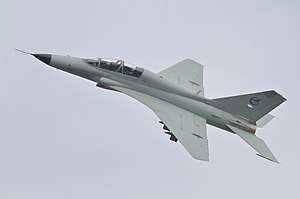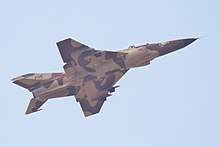Guizhou JL-9
The Guizhou JL-9, also known as the FTC-2000 Mountain Eagle (Chinese: 山鹰; pinyin: Shānyīng), is a two-seat supersonic fighter-trainer developed by the Guizhou Aviation Industry Import/Export Company (GAIEC) for the People's Liberation Army Air Force (PLAAF) and the People's Liberation Army Naval Air Force (PLANAF).[1]
| JL-9 | |
|---|---|
 | |
| An FTC-2000G at the Zhuhai Airshow, 2018 | |
| Role | Supersonic advanced Trainer/attack |
| Manufacturer | Guizhou Aviation Industry Import/Export Company (GAIEC) |
| Designer | Aero Engine Research Institute of Guizhou Aviation Industry Corporation |
| First flight | 13 December 2003 |
| Status | In service |
| Primary user | People's Liberation Army Air Force |
| Developed from | Chengdu JJ-7 |
Development
The FTC-2000 started as a GAIEC private venture to develop an inexpensive trainer for fourth generation aircraft. The trainer was revealed at the 2001 China International Aviation & Aerospace Exhibition.[2] The aircraft are reported to be produced at a GAIC assembly line in Anshun, Guizhou.[3]
The FTC-2000, as the JL-9, competed with the Hongdu JL-10 to meet the advanced trainer requirements of the PLAAF and PLANAF. The JL-10 is more technologically advanced, but also more expensive, than the JL-9. In 2013, both had entered production.[4]
A carrier-landing trainer variant was revealed by Chinese state media in 2011.[4] Designated the JL-9G, it has strengthened undercarriage, enlarged wing and diverterless supersonic inlets, but has proved to be unsuitable for arrested landings and is limited to land-based operations.[5]
On 5 September 2018, Chinese state-run Xinhua News Agency reported that GAIC had begun mass production of the FTC-2000G variant.,[6] on 28 September it was reported that the first mass-produced FTC-2000G performed its maiden flight.[7][8] In April 2020, China reported that an unnamed South-East Asian country had placed an order for the FTC-2000G, with deliveries expected between 2021 and 2023.[9]
Design

The FTC-2000 is a JJ-7/FT-7 with a new wing, a forward fuselage with side air intakes, and a glass cockpit. The engine, empennage, and mechanical controls of the JJ-7/FT-7 are retained.[2]
The FTC-2000G is a multi-role combat fighter aircraft and one of the cheapest multirole fighters on the market with the aim to replace old legacy fighters like the J-7/F-7. It has 7 hardpoints.[10] It also features a diverterless supersonic inlet.[11] It made its first flight in September 2018.[12] Compared to the FTC-2000 trainer variant, the FTC-2000G is heavier,[10] slower due to new wing design,[11][13] and has less endurance[10] than the FTC-2000.
The JL-9G is a modified JL-9 for aircraft carrier training. It is designed for ski-jump ramp takeoffs and simulated arrested landings (land-based).[14] and includes a tailhook.[14]
Operational history
The PLANAF had a regiment of JL-9s in 2014.[15]
The PLAAF began using the JL-9 for training on 18 October 2015.[16]
Variants
Operators
Specifications (FTC-2000)
Data from Jane's All the World's Aircraft 2010-11[1]
General characteristics
- Crew: 2
- Length: 14.555 m (47 ft 9 in) excluding nose-probe
- Wingspan: 8.32 m (27 ft 4 in)
- Height: 4.105 m (13 ft 6 in)
- Wing area: 26.15 m2 (281.5 sq ft)
- Gross weight: 7,800 kg (17,196 lb) clean
- 7,900 kg (17,417 lb) normal
- Max takeoff weight: 9,800 kg (21,605 lb)
- Fuel capacity: 2,000 kg (4,409 lb) internal + up to 1,302 kg (2,870 lb) in external tanks
- Powerplant: 1 × Guizhou Liyang WP-13F (C) afterburning turbojet, 43.15 kN (9,700 lbf) thrust dry, 63.25 kN (14,220 lbf) with afterburner
Performance
- Maximum speed: 1,100 km/h (680 mph, 590 kn) / M1.5
- Unstick and touchdown speed: 260 km/h (160 mph; 140 kn)
- Minimum flying speed: 210 km/h (130 mph; 110 kn)
- Cruise speed: 870 km/h (540 mph, 470 kn) [13]
- Stall speed: 125 km/h (78 mph, 67 kn) [13]
- Range: 863 km (536 mi, 466 nmi) on internal fuel
- Ferry range: 2,400 km (1,500 mi, 1,300 nmi) with maximum internal and external fuel
- Endurance: 3 hours
- Service ceiling: 16,000 m (52,000 ft)
- g limits: +8 -3
- Rate of climb: 150 m/s (30,000 ft/min) at sea level
- Wing loading: 374.8 kg/m2 (76.8 lb/sq ft)
- Thrust/weight: 0.00645 kN/kg (0.658 lbf/lb)
- Take-off run: 400–500 m (1,312–1,640 ft)
- Landing run: 700 m (2,297 ft)
Armament
- Guns: 1x 23mm cannon[16]
- Hardpoints: 5 with a capacity of 2,000 kg (4,409 lb) maximum,with provisions to carry combinations of:
- Other: up to 3 x fuel tanks[16]
- Missiles: typically 2x PL-8 AAMs on inboard pylons + 2x PL-9 AAMs on outboard pylons
Avionics
- Pulse Doppler radar
- comms
- IFF
- Transponder
- EFIS
- HOTAS
- GPS / INS
See also
Related development
- Mikoyan-Gurevich MiG-21 (MiG-21 Bison, Type 88 India)
- Chengdu J-7
Aircraft of comparable role, configuration and era
- Hongdu JL-10
- BAE Systems Hawk
- Alenia Aermacchi M-346 Master
- Aero L-159 Alca
- KAI T-50 Golden Eagle
- Yakovlev Yak-130
- HAL HJT-36 Sitara
References
| Wikimedia Commons has media related to Guizhou JL-9. |
- Jackson, Paul, ed. (2010). Jane's All the World's Aircraft 2010-11 (101st ed.). London: Jane's Information Group. pp. 116–117. ISBN 978-0710629166.
- Fisher, Richard D., Jr (18 June 2015). "Paris Air Show 2015: China close to first FTC-2000 supersonic trainer sale in Africa". IHS Jane's 360. Archived from the original on 21 June 2015. Retrieved 29 July 2016.
- Grevatt, Jon (June 6, 2017). "China promotes FTC-2000 trainer for export". Jane's Information Group. Archived from the original on June 6, 2017. Retrieved June 7, 2017.
Commenting on the development, the State Administration of Science, Technology, and Industry for National Defense (SASTIND) – the agency responsible for Chinese defence industrial development – said the aircraft represented the first export aircraft produced at GAIC’s assembly line in city of Anshun in Guizhou province.
- Caffrey, Craig (2013). Aiming high: China's air ambitions (PDF) (Report). Jane's Information Group. p. 5. Archived (PDF) from the original on 24 January 2017. Retrieved 29 July 2016.
- Rupprecht, Andreas (March 2018). "China: Naval Aviation Training". Air International. pp. 46–49. ISSN 0306-5634.
- Dominguez, Gabriel (6 September 2018). "China begins series-producing FTC-2000G aircraft". IHS Jane's 360. London. Archived from the original on 7 September 2018. Retrieved 7 September 2018.
- Waldron, Greg (1 October 2018). "FTC-2000G conducts maiden flight". FlightGlobal. Singapore. Archived from the original on 6 October 2018. Retrieved 6 October 2018.
- Dominguez, Gabriel (28 September 2018). "China's first series-produced FTC-2000G makes maiden flight". IHS Jane's 360. Archived from the original on 6 October 2018. Retrieved 6 October 2018.
- Waldron, Greg (20 April 2020). "AVIC FTC-2000G snags first export order". FlightGlobal. Retrieved 20 April 2020.
- wminnick (20 November 2012). "China's FTC-2000 Upgraded". Defense News. Retrieved 29 July 2016.
- "FTC-2000 G". Aviation Industry Corporation of China. Archived from the original on 29 August 2016. Retrieved 29 July 2016.
- "China's FTC-2000G fighter aircraft conducts maiden flight". Air Force Technology. Archived from the original on 19 October 2018. Retrieved 19 October 2018.
- "FTC-2000". Aviation Industry Corporation of China. Archived from the original on 29 August 2016. Retrieved 29 July 2016.
- COVERT AFFAIR A. Mladenov, Air International, March 2013, p. 93
- International Institute for Strategic Studies (2014). Hacket, James (ed.). The Military Balance 2014. Oxfordshire: Routledge. p. 235. ISBN 978-1-85743-722-5.
- Waldron, Greg (29 October 2015). "Chinese cadets start using JL-9 advanced jet trainer". Flight International. Archived from the original on 18 August 2016. Retrieved 29 July 2016.
- NEWS - Asia & Australasia, Air International, August 2011, p. 16.
- Binnie, Jeremy (16 May 2018). "Sudan's new FTC-2000 jets arrive". IHS Jane's 360. Archived from the original on 17 May 2018. Retrieved 16 May 2018.